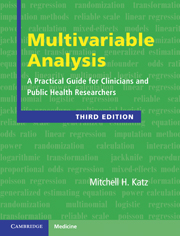Book contents
- Frontmatter
- Contents
- Preface
- 1 Introduction
- 2 Common uses of multivariable models
- 3 Outcome variables in multivariable analysis
- 4 Independent variables in multivariable analysis
- 5 Relationship of independent variables to one another
- 6 Setting up a multivariable analysis
- 7 Performing the analysis
- 8 Interpreting the results
- 9 Delving deeper: Checking the underlying assumptions of the analysis
- 10 Propensity scores
- 11 Correlated observations
- 12 Validation of models
- 13 Special topics
- 14 Publishing your study
- 15 Summary: Steps for constructing a multivariable model
- Index
- References
14 - Publishing your study
Published online by Cambridge University Press: 01 April 2011
- Frontmatter
- Contents
- Preface
- 1 Introduction
- 2 Common uses of multivariable models
- 3 Outcome variables in multivariable analysis
- 4 Independent variables in multivariable analysis
- 5 Relationship of independent variables to one another
- 6 Setting up a multivariable analysis
- 7 Performing the analysis
- 8 Interpreting the results
- 9 Delving deeper: Checking the underlying assumptions of the analysis
- 10 Propensity scores
- 11 Correlated observations
- 12 Validation of models
- 13 Special topics
- 14 Publishing your study
- 15 Summary: Steps for constructing a multivariable model
- Index
- References
Summary
How much information about how I constructed my multivariable models should I include in the Methods section?
The editors of the major biomedical journals have developed guidelines on how much detail of the statistical analysis to include in manuscripts. While the guidelines are general, the editors articulate an important rule of thumb: “Describe statistical methods with enough detail to enable a knowledgeable reader with access to the original data to verify the reported results.”
Although that goal is important, anyone who has performed statistical analysis knows that it would be impossible to include every detail of the analysis in a manuscript. Imagine writing: “for each independent variable we assessed whether there was any difference in outcome between the ‘don't know’ category and the ‘missing’ category” or “for one variable, we found that there was a somewhat increased frequency of outcome in the ‘don't know’ versus the ‘missing’ category, so we …” I think you get the idea. Research requires thousands of decisions. The readers rely on you to make the right ones. It is your responsibility, however, to report on the important choices you made, especially those that influence the results.
Published articles and journals differ in how they organize the information in the Methods section. I prefer dividing the Methods section into a review of how subjects were enrolled (Subjects), what interventions were used or how data were acquired (Procedures), how the variables were coded (Measures), and how the data were analyzed (Statistical analysis).
Information
- Type
- Chapter
- Information
- Multivariable AnalysisA Practical Guide for Clinicians and Public Health Researchers, pp. 221 - 226Publisher: Cambridge University PressPrint publication year: 2011
